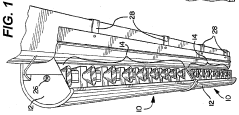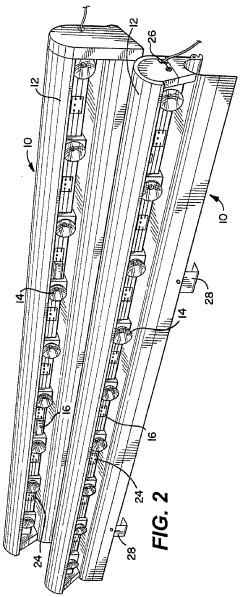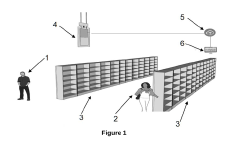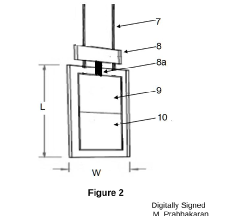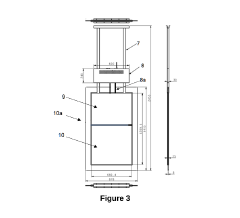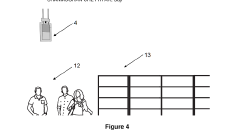ULED in Visual Merchandising: A Strategic Overview
JUN 23, 20259 MIN READ
Generate Your Research Report Instantly with AI Agent
Patsnap Eureka helps you evaluate technical feasibility & market potential.
ULED Technology Evolution
ULED (Ultra Light Emitting Diode) technology has undergone significant evolution since its inception, revolutionizing the visual merchandising landscape. The journey of ULED began with the development of traditional LED technology, which laid the foundation for more advanced lighting solutions.
In the early stages, LED technology faced challenges such as limited color range and brightness. However, continuous research and development led to the creation of high-brightness LEDs, which marked a crucial milestone in the evolution of ULED technology. These advancements paved the way for more efficient and vibrant lighting solutions in visual merchandising.
The next phase in ULED evolution saw the introduction of RGB (Red, Green, Blue) LED technology. This breakthrough allowed for a wider color gamut and more precise color control, enabling retailers to create more dynamic and engaging displays. The ability to produce a vast array of colors from a single light source opened up new possibilities for creative visual merchandising.
As the technology progressed, manufacturers focused on improving energy efficiency and reducing heat generation. This led to the development of more compact and powerful ULED modules, which could be easily integrated into various display fixtures and environments. The reduced power consumption and heat output made ULED an increasingly attractive option for retailers looking to minimize operational costs and environmental impact.
The advent of smart lighting systems marked another significant leap in ULED technology. Integration with digital control systems allowed for programmable lighting scenarios, enabling retailers to adjust brightness, color temperature, and even create dynamic lighting effects. This level of control enhanced the ability to create immersive and responsive retail environments.
Recent years have seen a focus on improving the color rendering index (CRI) of ULED technology. High CRI values ensure that products displayed under ULED lighting appear in their true colors, which is crucial for accurate representation in visual merchandising. This development has been particularly important in industries such as fashion and cosmetics, where color accuracy is paramount.
The latest advancements in ULED technology include the integration of IoT (Internet of Things) capabilities. This allows for remote monitoring and control of lighting systems, as well as the collection of valuable data on customer interactions and preferences. Such insights can be used to optimize store layouts and product placements, further enhancing the effectiveness of visual merchandising strategies.
Looking ahead, the evolution of ULED technology is expected to continue with a focus on miniaturization, increased efficiency, and enhanced connectivity. These developments will likely lead to even more flexible and powerful lighting solutions for visual merchandising, enabling retailers to create increasingly sophisticated and personalized shopping experiences.
In the early stages, LED technology faced challenges such as limited color range and brightness. However, continuous research and development led to the creation of high-brightness LEDs, which marked a crucial milestone in the evolution of ULED technology. These advancements paved the way for more efficient and vibrant lighting solutions in visual merchandising.
The next phase in ULED evolution saw the introduction of RGB (Red, Green, Blue) LED technology. This breakthrough allowed for a wider color gamut and more precise color control, enabling retailers to create more dynamic and engaging displays. The ability to produce a vast array of colors from a single light source opened up new possibilities for creative visual merchandising.
As the technology progressed, manufacturers focused on improving energy efficiency and reducing heat generation. This led to the development of more compact and powerful ULED modules, which could be easily integrated into various display fixtures and environments. The reduced power consumption and heat output made ULED an increasingly attractive option for retailers looking to minimize operational costs and environmental impact.
The advent of smart lighting systems marked another significant leap in ULED technology. Integration with digital control systems allowed for programmable lighting scenarios, enabling retailers to adjust brightness, color temperature, and even create dynamic lighting effects. This level of control enhanced the ability to create immersive and responsive retail environments.
Recent years have seen a focus on improving the color rendering index (CRI) of ULED technology. High CRI values ensure that products displayed under ULED lighting appear in their true colors, which is crucial for accurate representation in visual merchandising. This development has been particularly important in industries such as fashion and cosmetics, where color accuracy is paramount.
The latest advancements in ULED technology include the integration of IoT (Internet of Things) capabilities. This allows for remote monitoring and control of lighting systems, as well as the collection of valuable data on customer interactions and preferences. Such insights can be used to optimize store layouts and product placements, further enhancing the effectiveness of visual merchandising strategies.
Looking ahead, the evolution of ULED technology is expected to continue with a focus on miniaturization, increased efficiency, and enhanced connectivity. These developments will likely lead to even more flexible and powerful lighting solutions for visual merchandising, enabling retailers to create increasingly sophisticated and personalized shopping experiences.
Visual Merchandising Market Analysis
The visual merchandising market has experienced significant growth in recent years, driven by the increasing focus on enhancing customer experience and boosting sales in retail environments. This market encompasses a wide range of products and services, including display fixtures, mannequins, digital signage, and lighting solutions. The global visual merchandising market was valued at approximately $28 billion in 2020 and is projected to reach $40 billion by 2027, growing at a CAGR of around 5.5% during the forecast period.
One of the key factors driving market growth is the rising adoption of digital technologies in retail spaces. Retailers are increasingly incorporating interactive displays, augmented reality (AR), and virtual reality (VR) solutions to create immersive shopping experiences. This trend has been further accelerated by the COVID-19 pandemic, which has prompted retailers to explore contactless and digital-first approaches to visual merchandising.
The fashion and apparel sector remains the largest end-user segment in the visual merchandising market, accounting for over 30% of the market share. This is followed by the food and beverage industry, which has seen a surge in demand for innovative display solutions to showcase products in an appealing manner. The electronics and consumer goods sectors are also significant contributors to market growth, as these industries increasingly focus on creating engaging in-store experiences to compete with online retailers.
Geographically, North America and Europe are the leading markets for visual merchandising, owing to the presence of established retail chains and high consumer spending power. However, the Asia-Pacific region is expected to witness the fastest growth in the coming years, driven by rapid urbanization, increasing disposable incomes, and the expansion of organized retail in countries like China and India.
The integration of advanced lighting technologies, such as ULED (Ultra Light Emitting Diode), is emerging as a game-changing trend in the visual merchandising market. ULED technology offers superior color accuracy, brightness, and energy efficiency compared to traditional lighting solutions. This innovation is particularly relevant for retailers looking to create visually striking displays while also reducing their energy consumption and operational costs.
As sustainability becomes an increasingly important consideration for both retailers and consumers, there is a growing demand for eco-friendly visual merchandising solutions. This includes the use of recyclable materials, energy-efficient lighting, and modular display systems that can be easily repurposed or recycled. The shift towards sustainable practices is not only driven by environmental concerns but also by potential cost savings and improved brand perception among environmentally conscious consumers.
One of the key factors driving market growth is the rising adoption of digital technologies in retail spaces. Retailers are increasingly incorporating interactive displays, augmented reality (AR), and virtual reality (VR) solutions to create immersive shopping experiences. This trend has been further accelerated by the COVID-19 pandemic, which has prompted retailers to explore contactless and digital-first approaches to visual merchandising.
The fashion and apparel sector remains the largest end-user segment in the visual merchandising market, accounting for over 30% of the market share. This is followed by the food and beverage industry, which has seen a surge in demand for innovative display solutions to showcase products in an appealing manner. The electronics and consumer goods sectors are also significant contributors to market growth, as these industries increasingly focus on creating engaging in-store experiences to compete with online retailers.
Geographically, North America and Europe are the leading markets for visual merchandising, owing to the presence of established retail chains and high consumer spending power. However, the Asia-Pacific region is expected to witness the fastest growth in the coming years, driven by rapid urbanization, increasing disposable incomes, and the expansion of organized retail in countries like China and India.
The integration of advanced lighting technologies, such as ULED (Ultra Light Emitting Diode), is emerging as a game-changing trend in the visual merchandising market. ULED technology offers superior color accuracy, brightness, and energy efficiency compared to traditional lighting solutions. This innovation is particularly relevant for retailers looking to create visually striking displays while also reducing their energy consumption and operational costs.
As sustainability becomes an increasingly important consideration for both retailers and consumers, there is a growing demand for eco-friendly visual merchandising solutions. This includes the use of recyclable materials, energy-efficient lighting, and modular display systems that can be easily repurposed or recycled. The shift towards sustainable practices is not only driven by environmental concerns but also by potential cost savings and improved brand perception among environmentally conscious consumers.
ULED Challenges in Retail
The integration of Ultra-Light Emitting Diode (ULED) technology in visual merchandising presents several challenges for retailers. One of the primary obstacles is the high initial cost of implementing ULED displays. While these displays offer superior image quality and energy efficiency in the long run, the upfront investment can be substantial, particularly for small to medium-sized businesses with limited budgets.
Another significant challenge is the complexity of installation and maintenance. ULED displays often require specialized knowledge and skills for proper setup and ongoing care. This necessitates either extensive training for existing staff or the hiring of external experts, both of which can strain resources and potentially disrupt operations during implementation.
Compatibility with existing systems and infrastructure is also a concern. Many retailers have established visual merchandising setups, and integrating ULED technology may require significant modifications to store layouts, power systems, and content management processes. This can lead to additional costs and logistical challenges, especially for retailers with multiple locations or those operating in older buildings with outdated infrastructure.
The rapid pace of technological advancement in the display industry poses another challenge. Retailers must carefully consider the long-term viability of their ULED investments, as newer technologies may emerge, potentially rendering current systems obsolete. This risk of technological obsolescence can make decision-makers hesitant to commit to large-scale ULED implementations.
Content creation and management for ULED displays can also be challenging. The high resolution and color accuracy of ULED technology demand high-quality content to fully leverage its capabilities. This may require retailers to invest in new content creation tools and processes, as well as to develop new skills within their marketing teams.
Environmental concerns, while not unique to ULED, still present challenges. Although ULED technology is more energy-efficient than traditional display options, the production and eventual disposal of these displays raise questions about electronic waste and sustainability. Retailers must consider these factors in their corporate social responsibility strategies.
Lastly, there are regulatory and compliance issues to navigate. As a relatively new technology, ULED displays may be subject to evolving standards and regulations regarding energy consumption, light pollution, and public safety. Staying abreast of these changes and ensuring compliance across multiple jurisdictions can be a significant challenge for retailers, especially those with a global presence.
Another significant challenge is the complexity of installation and maintenance. ULED displays often require specialized knowledge and skills for proper setup and ongoing care. This necessitates either extensive training for existing staff or the hiring of external experts, both of which can strain resources and potentially disrupt operations during implementation.
Compatibility with existing systems and infrastructure is also a concern. Many retailers have established visual merchandising setups, and integrating ULED technology may require significant modifications to store layouts, power systems, and content management processes. This can lead to additional costs and logistical challenges, especially for retailers with multiple locations or those operating in older buildings with outdated infrastructure.
The rapid pace of technological advancement in the display industry poses another challenge. Retailers must carefully consider the long-term viability of their ULED investments, as newer technologies may emerge, potentially rendering current systems obsolete. This risk of technological obsolescence can make decision-makers hesitant to commit to large-scale ULED implementations.
Content creation and management for ULED displays can also be challenging. The high resolution and color accuracy of ULED technology demand high-quality content to fully leverage its capabilities. This may require retailers to invest in new content creation tools and processes, as well as to develop new skills within their marketing teams.
Environmental concerns, while not unique to ULED, still present challenges. Although ULED technology is more energy-efficient than traditional display options, the production and eventual disposal of these displays raise questions about electronic waste and sustainability. Retailers must consider these factors in their corporate social responsibility strategies.
Lastly, there are regulatory and compliance issues to navigate. As a relatively new technology, ULED displays may be subject to evolving standards and regulations regarding energy consumption, light pollution, and public safety. Staying abreast of these changes and ensuring compliance across multiple jurisdictions can be a significant challenge for retailers, especially those with a global presence.
Current ULED Solutions
01 ULED structure and composition
Ultra Light Emitting Diodes (ULEDs) are advanced semiconductor devices with unique structural and compositional features. They are designed to emit light with high efficiency and brightness while maintaining a compact form factor. The structure typically includes specialized layers of semiconductor materials and may incorporate novel materials or quantum structures to enhance performance.- ULED structure and composition: Ultra Light Emitting Diodes (ULEDs) are advanced semiconductor devices with unique structural and compositional features. They are designed to emit light with high efficiency and brightness while maintaining a compact form factor. The structure typically includes specialized layers of semiconductor materials and may incorporate novel materials or nanostructures to enhance performance.
- ULED manufacturing processes: The manufacturing of ULEDs involves sophisticated processes to achieve their ultra-small size and high performance. These may include advanced epitaxial growth techniques, precise doping methods, and nanoscale fabrication processes. Special attention is given to maintaining high quality and uniformity in production to ensure consistent performance across devices.
- ULED applications in displays: ULEDs are increasingly being used in display technologies, offering advantages such as higher brightness, better color accuracy, and improved energy efficiency compared to traditional LEDs. They are particularly suitable for high-resolution displays in smartphones, televisions, and other electronic devices where space is at a premium and high performance is crucial.
- ULED power efficiency and thermal management: A key feature of ULEDs is their high power efficiency, which allows for brighter light output with lower energy consumption. However, this also presents challenges in thermal management due to the concentration of energy in a small area. Advanced thermal management techniques and materials are employed to dissipate heat effectively and maintain optimal performance.
- ULED integration with control circuits: The integration of ULEDs with sophisticated control circuits is crucial for their operation in various applications. This includes the development of specialized drivers, dimming controls, and color management systems. The integration aims to maximize the performance of ULEDs while ensuring compatibility with existing electronic systems and standards.
02 ULED manufacturing processes
The manufacturing of ULEDs involves sophisticated processes to achieve their ultra-small size and high performance. These may include advanced epitaxial growth techniques, precise doping methods, and nanoscale fabrication processes. Special attention is given to maintaining high quality and uniformity in production to ensure consistent performance across devices.Expand Specific Solutions03 ULED applications in displays
ULEDs are increasingly being used in display technologies, offering advantages such as higher brightness, better color accuracy, and improved energy efficiency compared to traditional LEDs. They are particularly suitable for high-resolution displays in various devices, including smartphones, televisions, and wearable technology.Expand Specific Solutions04 ULED power efficiency and thermal management
A key feature of ULEDs is their high power efficiency, which allows for brighter output with lower energy consumption. This efficiency also results in less heat generation, but effective thermal management is still crucial for maintaining performance and longevity. Innovative heat dissipation techniques and materials are often employed in ULED designs.Expand Specific Solutions05 ULED integration with control circuits
The integration of ULEDs with sophisticated control circuits is essential for optimizing their performance in various applications. These circuits can manage power delivery, adjust brightness levels, and coordinate color output. Advanced driver ICs and control algorithms are developed to fully leverage the capabilities of ULEDs in complex lighting and display systems.Expand Specific Solutions
Key ULED Manufacturers
The ULED technology in visual merchandising is in its growth phase, with a rapidly expanding market driven by increasing demand for high-quality display solutions in retail environments. The global market size for ULED in visual merchandising is projected to reach significant figures in the coming years, fueled by advancements in display technology and the need for immersive shopping experiences. Technologically, ULED is maturing quickly, with companies like BOE Technology Group, Lumileds, and Koninklijke Philips leading the way in innovation. These firms, along with others like Sharp and NVIDIA, are pushing the boundaries of ULED capabilities, focusing on aspects such as energy efficiency, color accuracy, and seamless integration with smart retail systems. The competitive landscape is diverse, featuring both established electronics giants and specialized display technology firms, indicating a robust and dynamic market with ample room for technological advancements and market growth.
BOE Technology Group Co., Ltd.
Technical Solution: BOE has developed advanced ULED (Ultra LED) technology for visual merchandising applications. Their ULED displays offer ultra-high contrast ratios, wide color gamut, and HDR capabilities. BOE's ULED panels utilize quantum dot technology and local dimming to achieve superior image quality. For visual merchandising, they have created large-format ULED video walls and transparent ULED displays that can be integrated into store windows and product showcases. These displays provide vivid, lifelike product presentations and interactive shopping experiences.
Strengths: Superior image quality, energy efficiency, and versatility for various retail environments. Weaknesses: Higher initial cost compared to traditional displays, potential for image retention with static content.
Hussmann Corp.
Technical Solution: Hussmann, a leader in refrigeration and food retail solutions, has integrated ULED technology into their visual merchandising offerings. They have developed ULED-lit refrigerated display cases that combine energy-efficient lighting with superior product visibility. Hussmann's ULED solutions include dynamic lighting controls that can adjust color temperature and intensity based on the time of day or specific promotions. They have also created ULED-enhanced shelf-edge displays for pricing and product information, which can be updated in real-time. Hussmann's approach focuses on seamlessly integrating ULED technology with their existing refrigeration and display systems to create cohesive, high-impact visual merchandising solutions for grocery and convenience stores.
Strengths: Specialized expertise in food retail, integrated solutions combining refrigeration and lighting. Weaknesses: Limited application outside of food retail, potential for higher costs due to specialized nature of products.
ULED Innovations for Retail
LED lighting assembly and method of lighting for a merchandise display
PatentWO2012074781A2
Innovation
- An LED lighting assembly with a circuit board and integral lens assembly that captures and modifies the beam pattern of LEDs to re-project light evenly across a vertical plane, using adjustable lenses and a thermally efficient design to enhance illumination and reduce energy consumption.
Ultra slim LCD category header having dual sided display provided with video advertisement in supermarkets
PatentPendingIN202341071595A
Innovation
- An ultra-slim dual-sided LCD category header system with integrated controller, connected via Wi-Fi, utilizing a cloud-based data-driven media management system to display dynamic category descriptions and video advertisements, replacing traditional foam or plastic-based signage.
Energy Efficiency of ULED
Energy efficiency is a critical factor in the adoption and implementation of ULED (Ultra Light Emitting Diode) technology in visual merchandising. ULED displays offer significant advantages over traditional lighting solutions, particularly in terms of power consumption and overall energy efficiency.
ULED technology utilizes advanced semiconductor materials and precise manufacturing processes to create highly efficient light-emitting diodes. These diodes can produce bright, vibrant light while consuming substantially less energy compared to conventional LED or fluorescent lighting systems. The energy efficiency of ULED is primarily attributed to its ability to convert a higher percentage of electrical energy into visible light, minimizing energy loss through heat dissipation.
In visual merchandising applications, ULED displays can achieve the same or higher brightness levels as traditional lighting solutions while consuming up to 30-40% less power. This reduction in energy consumption translates directly into lower operational costs for retailers and reduced environmental impact. The long lifespan of ULED technology, often exceeding 100,000 hours of operation, further contributes to its energy efficiency by reducing the frequency of replacements and associated energy costs.
ULED displays also offer superior color accuracy and consistency, which is crucial in visual merchandising. This enhanced color performance is achieved without compromising energy efficiency, as ULED technology can produce a wide color gamut using less power than conventional display technologies. The ability to accurately represent product colors while maintaining energy efficiency is a significant advantage in retail environments.
Moreover, ULED technology incorporates advanced power management features that further enhance its energy efficiency. These include dynamic backlighting, which adjusts the display's brightness based on ambient light conditions, and local dimming, which selectively dims or turns off LEDs in darker areas of the image. These features not only save energy but also improve the visual quality of the display, creating more impactful and engaging visual merchandising experiences.
The energy efficiency of ULED technology also extends to its thermal management capabilities. ULED displays generate less heat compared to traditional lighting solutions, reducing the need for additional cooling systems in retail environments. This indirect energy saving contributes to the overall efficiency of ULED-based visual merchandising solutions.
As sustainability becomes increasingly important in retail, the energy efficiency of ULED technology aligns well with green initiatives and environmental regulations. Retailers adopting ULED displays can demonstrate their commitment to reducing energy consumption and carbon footprint, potentially attracting environmentally conscious consumers and improving brand perception.
ULED technology utilizes advanced semiconductor materials and precise manufacturing processes to create highly efficient light-emitting diodes. These diodes can produce bright, vibrant light while consuming substantially less energy compared to conventional LED or fluorescent lighting systems. The energy efficiency of ULED is primarily attributed to its ability to convert a higher percentage of electrical energy into visible light, minimizing energy loss through heat dissipation.
In visual merchandising applications, ULED displays can achieve the same or higher brightness levels as traditional lighting solutions while consuming up to 30-40% less power. This reduction in energy consumption translates directly into lower operational costs for retailers and reduced environmental impact. The long lifespan of ULED technology, often exceeding 100,000 hours of operation, further contributes to its energy efficiency by reducing the frequency of replacements and associated energy costs.
ULED displays also offer superior color accuracy and consistency, which is crucial in visual merchandising. This enhanced color performance is achieved without compromising energy efficiency, as ULED technology can produce a wide color gamut using less power than conventional display technologies. The ability to accurately represent product colors while maintaining energy efficiency is a significant advantage in retail environments.
Moreover, ULED technology incorporates advanced power management features that further enhance its energy efficiency. These include dynamic backlighting, which adjusts the display's brightness based on ambient light conditions, and local dimming, which selectively dims or turns off LEDs in darker areas of the image. These features not only save energy but also improve the visual quality of the display, creating more impactful and engaging visual merchandising experiences.
The energy efficiency of ULED technology also extends to its thermal management capabilities. ULED displays generate less heat compared to traditional lighting solutions, reducing the need for additional cooling systems in retail environments. This indirect energy saving contributes to the overall efficiency of ULED-based visual merchandising solutions.
As sustainability becomes increasingly important in retail, the energy efficiency of ULED technology aligns well with green initiatives and environmental regulations. Retailers adopting ULED displays can demonstrate their commitment to reducing energy consumption and carbon footprint, potentially attracting environmentally conscious consumers and improving brand perception.
ULED Content Creation Strategies
Content creation strategies for ULED in visual merchandising require a multifaceted approach that leverages the unique capabilities of Ultra-LED technology. These strategies should focus on creating immersive and engaging experiences that captivate customers and drive sales.
One key strategy is to develop dynamic content that showcases the superior color range and contrast of ULED displays. This involves creating vibrant, high-resolution visuals that highlight product features and benefits. Designers should utilize the full spectrum of colors available, particularly emphasizing deep blacks and bright whites to create striking contrasts that draw attention to key elements.
Another important approach is to implement motion-based content that takes advantage of ULED's fast refresh rates and minimal motion blur. This can include smooth animations, seamless transitions, and even interactive elements that respond to customer movements or gestures. Such dynamic content can significantly increase engagement and dwell time in retail environments.
Personalization is also a crucial aspect of ULED content creation. By leveraging data analytics and AI, retailers can create adaptive content that changes based on factors such as time of day, weather conditions, or customer demographics. This tailored approach ensures that the displayed content remains relevant and compelling to the target audience.
3D content and augmented reality (AR) experiences represent another frontier in ULED visual merchandising. The high resolution and color accuracy of ULED displays make them ideal for showcasing 3D product renderings or creating AR overlays that allow customers to visualize products in different contexts or configurations.
Content creators should also consider the storytelling potential of ULED displays. By developing narrative-driven content that unfolds across multiple screens or over time, retailers can create a more immersive brand experience. This could include behind-the-scenes looks at product creation, customer testimonials, or brand heritage stories.
Lastly, it's essential to optimize content for different viewing distances and angles. ULED's wide viewing angles allow for flexible content placement, but creators must ensure that text remains legible and visuals impactful from various perspectives. This may involve creating multiple versions of content tailored for different display locations within a store.
By implementing these strategies, retailers can fully harness the power of ULED technology to create compelling visual merchandising experiences that drive customer engagement and sales.
One key strategy is to develop dynamic content that showcases the superior color range and contrast of ULED displays. This involves creating vibrant, high-resolution visuals that highlight product features and benefits. Designers should utilize the full spectrum of colors available, particularly emphasizing deep blacks and bright whites to create striking contrasts that draw attention to key elements.
Another important approach is to implement motion-based content that takes advantage of ULED's fast refresh rates and minimal motion blur. This can include smooth animations, seamless transitions, and even interactive elements that respond to customer movements or gestures. Such dynamic content can significantly increase engagement and dwell time in retail environments.
Personalization is also a crucial aspect of ULED content creation. By leveraging data analytics and AI, retailers can create adaptive content that changes based on factors such as time of day, weather conditions, or customer demographics. This tailored approach ensures that the displayed content remains relevant and compelling to the target audience.
3D content and augmented reality (AR) experiences represent another frontier in ULED visual merchandising. The high resolution and color accuracy of ULED displays make them ideal for showcasing 3D product renderings or creating AR overlays that allow customers to visualize products in different contexts or configurations.
Content creators should also consider the storytelling potential of ULED displays. By developing narrative-driven content that unfolds across multiple screens or over time, retailers can create a more immersive brand experience. This could include behind-the-scenes looks at product creation, customer testimonials, or brand heritage stories.
Lastly, it's essential to optimize content for different viewing distances and angles. ULED's wide viewing angles allow for flexible content placement, but creators must ensure that text remains legible and visuals impactful from various perspectives. This may involve creating multiple versions of content tailored for different display locations within a store.
By implementing these strategies, retailers can fully harness the power of ULED technology to create compelling visual merchandising experiences that drive customer engagement and sales.
Unlock deeper insights with Patsnap Eureka Quick Research — get a full tech report to explore trends and direct your research. Try now!
Generate Your Research Report Instantly with AI Agent
Supercharge your innovation with Patsnap Eureka AI Agent Platform!
